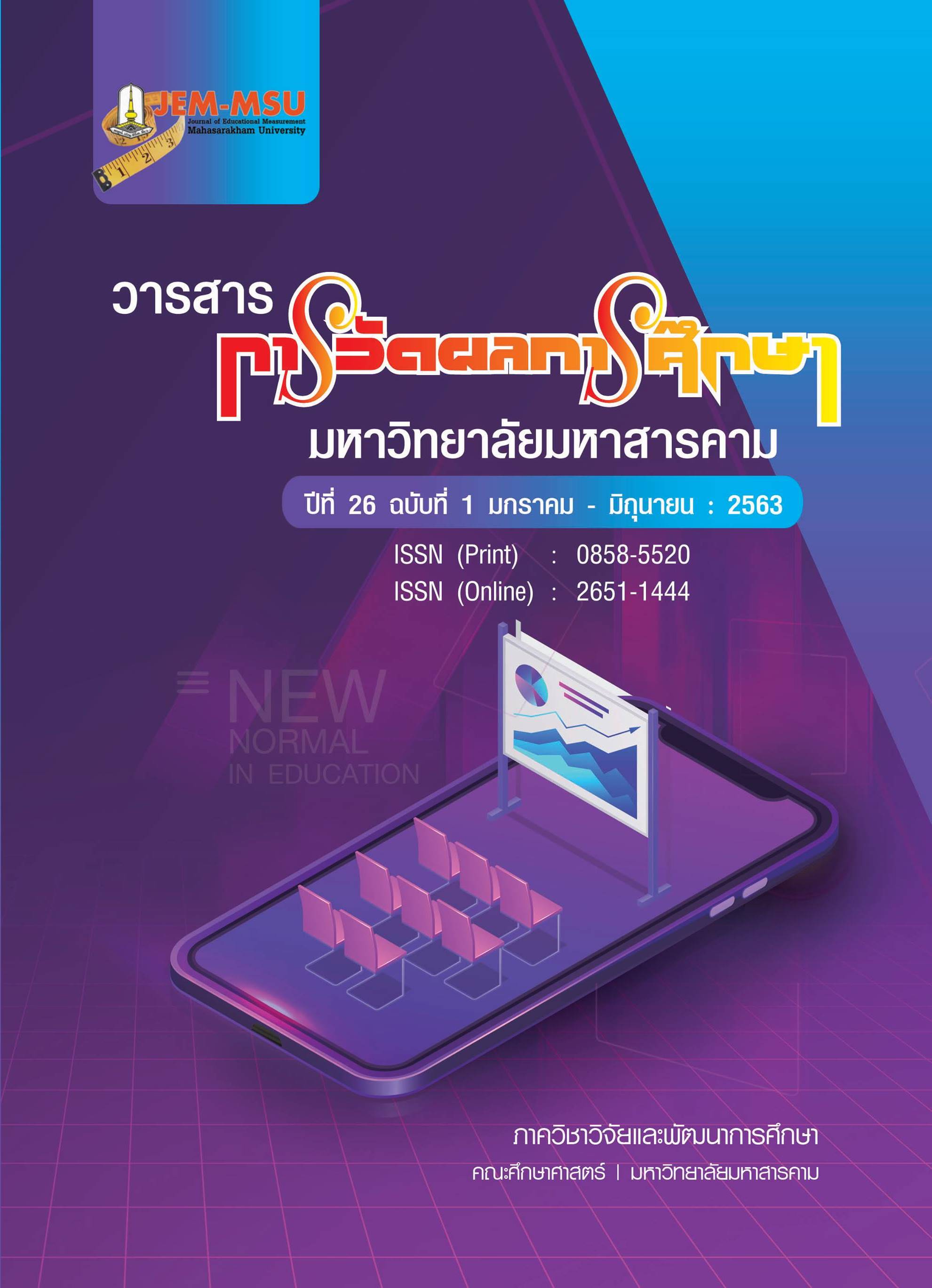A Study of the Current State and Problems of Higher Order Thinking of the Students in Watchaemarom School
Main Article Content
Abstract
The objectives of this research were: 1) to study the current state and problems of developing higher order thinking of the students of Watchaemarom School; 2) to study the higher order thinking level of the students of Watchaemarom School. The sample consisted of 90 people, classified as 8 school executives and teachers, 51 primary school students and 31 lower secondary school students of Watchaemarom School in the academic year 2017, obtained through multistage sampling. The research instruments were: 1) 2 sets of guidelines on questions for the focus group: (1) for the teachers and the school executives, and (2) for the student groups; 2) 4 higher order thinking test packages which consisted of the analytical thinking test, the critical thinking test, the problem-solving test and the creative test. The qualitative data analysis employed content analysis while the quantitative data analysis employed the mean, percentage and standard deviation.
The findings are as follows:
1. The school executives and teachers were well aware of the current state and problems of the students’ higher order thinking which were caused by the school budget, the school curriculum that had a lot of content, a lot of extra-curricular activities, the instructional strategies that emphasized the lecture and lacked activities for promoting the students’ thinking, and the students’ lack of the readiness for learning.
2. The higher order thinking of both primary and lower secondary school students were at a level below the standard. Only the problem solving of the lower secondary school students passed the criterion. When each aspect of higher order thinking was considered, it was found that:
The analytical thinking of both primary and lower secondary school students was lower than the standard, having the mean scores of 4.43 and 3.85 respectively. The analysis of principles had the lowest score.
The critical thinking of both primary and lower secondary school students was lower than the standard, having the mean scores of 7.30 and 6.75 respectively. Evaluation of arguments had the lowest score.
The problem solving thinking of primary school students was below the standard, having the mean score of 10.00, while that of the lower secondary school students passed the criterion with the mean score of 12.37. When considered by aspect, examining the outcome had the lowest score.
Article Details
The content and information contained in the published article in the Journal of Educational Measurement Mahasarakham University represent the opinions and responsibilities of the authors directly. The editorial board of the journal is not necessarily in agreement with or responsible for any of the content.
The articles, data, content, images, etc. that have been published in the Journal of Educational Measurement Mahasarakham University are copyrighted by the journal. If any individual or organization wishes to reproduce or perform any actions involving the entirety or any part of the content, they must obtain written permission from the Journal of Educational Measurement Mahasarakham University.
References
กรมวิชาการ กระทรวงศึกษาธิการ. (2551). หลักสูตรการศึกษาขั้นพื้นฐาน พุทธศักราช 2551. กรุงเทพฯ : โรงพิมพ์องค์การรับส่งสินค้าและพัสดุภัณฑ์.
ปรเมศร์ วงศ์ชาชม และกัญญารัตน์ โคจร. (2559). การพัฒนาความคิดสร้างสรรค์และผลสัมฤทธิ์ทางการเรียนของนักเรียนชั้นมัธยมศึกษาปีที่ 5 โดยใช้การจัดการเรียนรู้ตามแนวคิดสะเต็มศึกษาร่วมกับโครงงานเป็นฐาน. วารสารศึกษาศาสตร์ มหาวิทยาลัยมหาสารคาม, 10(พิเศษ): 463-474.
ประพันธ์ศิริ สุเสารัจ. (2556). การพัฒนาการคิด. กรุงเทพฯ : โรงพิมพ์ หจก.9119 เทคนิคพริ้นติ้ง.
รวีวรรณ ชินะตระกูล. (2554). ปัจจัยที่ส่งผลต่อการทำโครงงานวิทยาศาสตร์และเทคโนโลยีของนักศึกษาในประเทศญี่ปุ่นและประเทศไทย. กรุงเทพฯ: สำนักงานคณะกรรมการการศึกษาแห่งชาติ.
รัฐพงษ์ มะพันธ์ และกัญญารัตน์ โคจร. (2559). ผลการจัดการเรียนรู้วิทยาศาสตร์ ตามแนวคิดการใช้ปัญหาเป็นฐานร่วมกับแผนผังความคิด เพื่อส่งเสริมผลสัมฤทธิ์ทางการเรียนและการคิดวิเคราะห์ ของนักเรียนชั้นมัธยมศึกษาปีที่ 4. วารสารศึกษาศาสตร์ มหาวิทยาลัยมหาสารคาม, 10 (พิเศษ): 689-703.
ราชบัณฑิตยสถาน. (2556). พจนานุกรม ฉบับราชบัณฑิตยสถาน พ.ศ. ๒๕๕๔ เฉลิมพระเกียรติพระบาทสมเด็จ พระเจ้าอยู่หัว เนื่องในโอกาสพระราชพิธีมหามงคลเฉลิมพระชนมพรรษา ๗ รอบ ๕ ธันวาคม ๒๕๕๔. กรุงเทพฯ : ราชบัณฑิตยสถาน.
โรงเรียนวัดแจ่มอารมณ์. (2559). รายงานประจำปีของสถานศึกษา. โรงเรียนวัดแจ่มอารมณ์: ร้อยเอ็ด.
วรพจน์ วงศ์กิจรุ่งเรือและ อธิป จิตตฤกษ์. (2554). ทักษะแห่งอนาคตใหม่: การศึกษาเพื่อศตวรรษที่ 21 = 21st Century Skills: Rethinking How Students Learn. กรุงเทพฯ: โอเพ่นเวิลด์.
วิริยะ ฤาชัยพาณิชย์. (2558). การสอนแบบสร้างสรรค์เป็นฐาน Creativity-based Learning (CBL). วารสารนวัตกรรมการเรียนรู้, 1(2): 23-37.
สถาบันส่งเสริมการสอนวิทยาศาสตร์และเทคโนโลยี (สสวท.). (2560). สรุปข้อมูลเบื้องต้น PISA 2015, กรุงเทพฯ: สถาบันส่งเสริมการสอนวิทยาศาสตร์และเทคโนโลยี.
สุคนธ์ สินธพานนท์, วรรัตน์ วรรณเลิศลักษณ์ และพรรณี สินธพานนท์. (2555). พัฒนาทักษะการคิด ตามแนวปฏิรูปการศึกษา.กรุงเทพฯ : ห้างหุ้นส่วนจำกัด 9119 เทคนิคพริ้นติ้ง.
สุภพงษ์ วงศ์สมิตกุล. (2548). การพัฒนาชุดการสอนแบบอิงประสบการณ์ กลุ่มสาระการงานอาชีพและเทคโนโลยี เรื่องการเพาะเห็ดหอม สำหรับนักเรียนชั้นมัธยมศึกษาปีที่ 4-6 โรงเรียนปากช่อง จังหวัดนครราชสีมา. โครงการจากหิ้งสู่ห้องเพื่อขยายผลสู่ห้องเรียน. สำนักงานการศึกษาขั้นพื้นฐาน.
สุวิมล ว่องวานิช. (2558). การวิจัยประเมินความต้องการจำเป็น. พิมพ์ครั้งที่ 3. กรุงเทพฯ : สำนักพิมพ์แห่ง จุฬาลงกรณ์มหาวิทยาลัย.
สำนักวิจัยและพัฒนาการศึกษาสำนักงานเลขาธิการสภาการศึกษา กระทรวงศึกษาธิการ. (2561). สภาวการณ์การศึกษาไทยในเวทีโลกพ.ศ.2559/2560.กรุงเทพฯ: บริษัทหวานกราฟิก จำกัด.
เอื้อมพร หลินเจริญและคณะ. (2552). ปัจจัยเชิงสาเหตุที่ทำให้คะแนนการทดสอบโอเน็ตของนักเรียนชั้นประถมศึกษาปีที่ 6 และชั้นมัธยมศึกษาปีที่ 6. คณะศึกษาศาสตร์ มหาวิทยาลัยนเรศวร.
Guilford, J.P. (1991). The Nature of Human Intelligence. New York: McGraw-Hill.
Wongchachom, P. & Cojorn, K. (2016). A Survey of Critical Thinking Skill of Matthayomsueksa 5 Students in Thailand. In IAB Chair: Professor Stuart D.B. Picken (Eds.), Proceeding of the Asian Conference on Education & International Development 2016 (pp. 227-236). Art Center Kobe, Japan: The International Academic Forum.
Weir, J.J. (1974). Problem Solving Every body’s Problem. The Science Teacher. 4 (April), 16-18.


